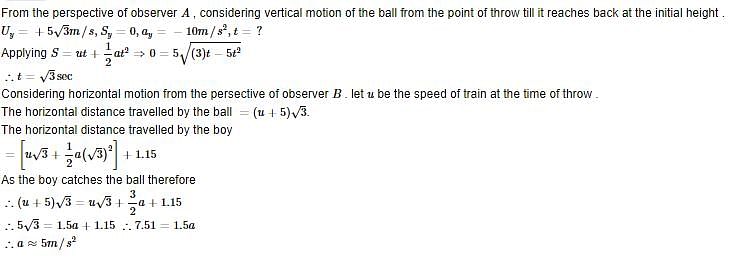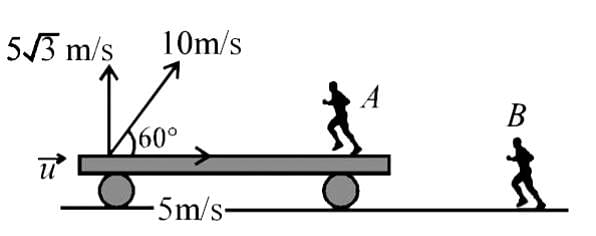Test: JEE Previous Year Questions- Motion in a Straight Line - JEE MCQ
9 Questions MCQ Test Chapter-wise Tests for JEE Main & Advanced - Test: JEE Previous Year Questions- Motion in a Straight Line
In 1.0 sec. a particle goes from point A to point B moving in a semicircle of radius 1.0 m. The magnitude of average velocity is -

[JEE `99]
A ball is dropped vertically from a height d above the ground it hits the ground and bounces up vertically to a height d/2. Neglecting subsequent motion and air resistances, its velocity v varies with the height h above the ground as -
[JEE' 2000 (Scr)]
An object A is kept fixed at the point x = 3 m and y = 1.25 m on a plank P raised above the ground. At time t = 0 the plank starts moving along the +x direction with an acceleration 1.5 m/s2. At the same instant a stone is projected from the origin with a velocity u as shown. A stationary person on the ground observes the stone hitting the object during its downward motion at an angle of 45° to the horizontal. All the motions are in x-y plane. Find u and the time after which the stone hits the object. Take g = 10 m/s2

[JEE 2000]
On a frictionless horizontal surface, assumed to be the x-y plane, a small trolley A is moving along a straight line parallel to the y-axis (see figure) with a constant velocity of m/s. At a particular instant, when the line OA makes an angle of 45° with the x-axis, a ball is thrown along the surface from the origin O. Its velocity makes an angle f with the x-axis and it hits the trolley.
(a) The motion of the ball is observed from the frame of trolley. Calculate the angle q made by the velocity vector of the ball with the x-axis in this frame.
(b) Find the speed of the ball with respect to the surface, if f = .
[JEE 2002]
A particle starts from rest. Its acceleration (a) varsus time (t) is as shown in the figure. The maximum speed of the particle will be - [JEE' 2004 (Scr)]
A small block slides without friction down an inclined plane starting from rest. Let Sn be the distance travelled from time t = n-1 to t = n. Then Sn/Sn+1 is- [JEE' 2004 (Scr)]
The velocity displacement graph of a particle moving along a straight line is shown. The most suitable acceleration-displacement graph will be -
Statement-1
For an observer looking out through the window of a fast moving train, the nearby objects appear to move in the opposite direction to the train, while the distant objects appear to be stationary.
Statement-2
If the observer and the object are moving at velocities and
respectively with reference to a laboratory frame, the velocity of the object with respect to the observer is
[JEE' 2008]
A train is moving along a straight line with a constant acceleration 'a'. A boy standing in the train throws a ball forward with a speed of 10 m/s, at an angle of 60° to the horizontal. The boy has to move forward by 1.15 m inside the train to catch the ball back at the initial height. The acceleration of the train in m/s2 is [JEE' 2011]
|
446 docs|930 tests
|















